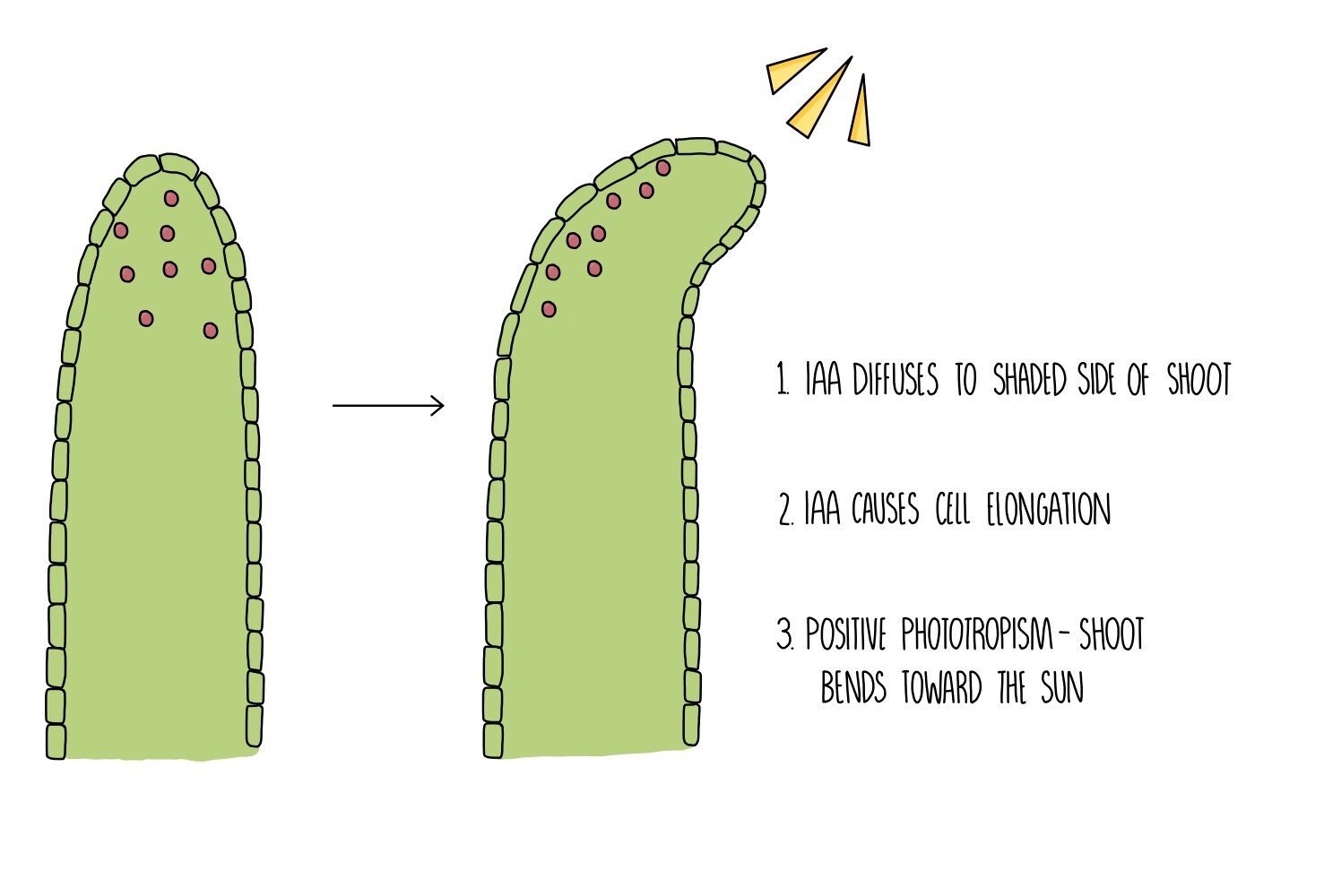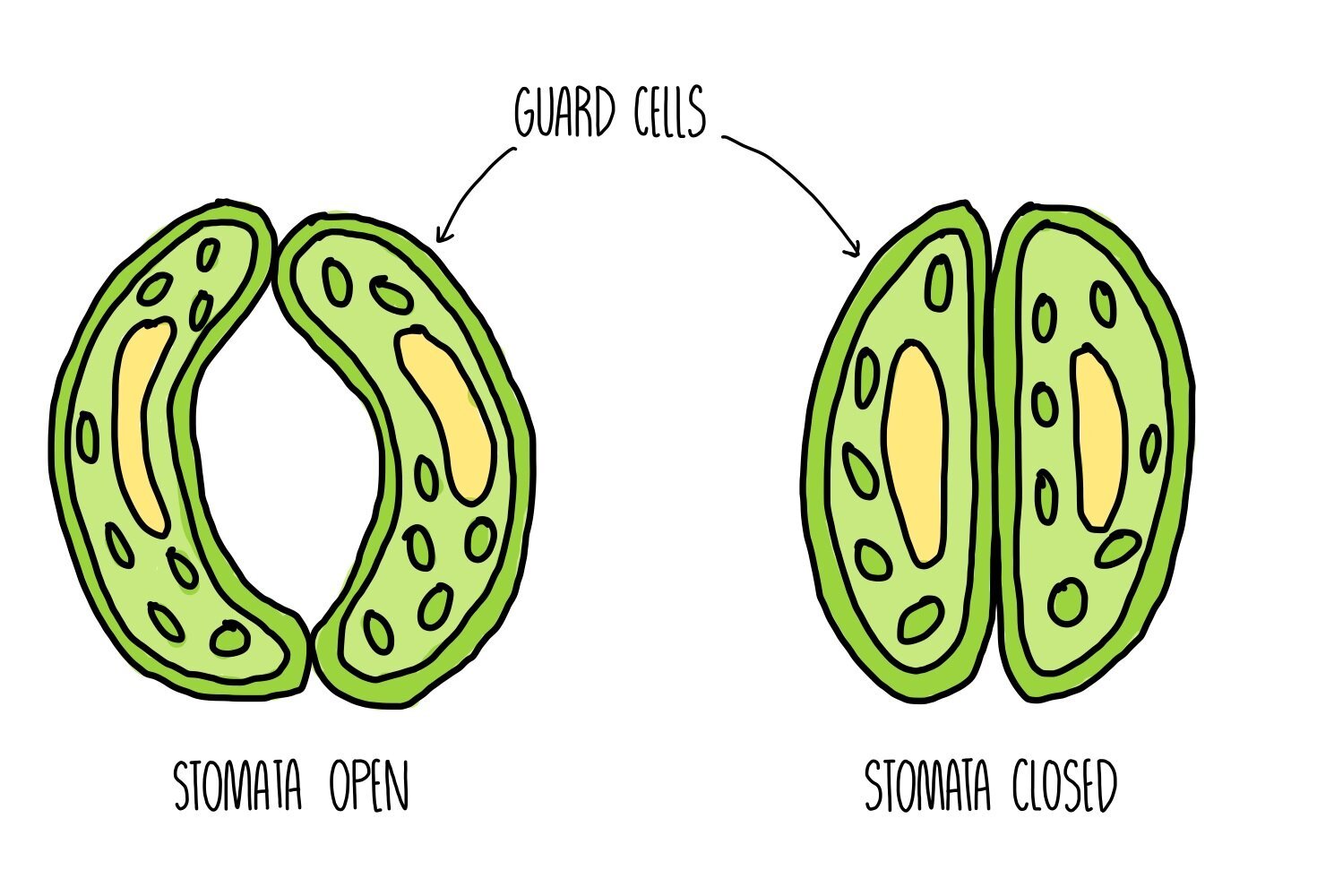Plant Responses
Plant responses
Plants increase their survival chances by responding to herbivores and environmental stress. They protect themselves against herbivory using toxic chemicals, communication with other plants and physical responses:
Some plants produce alkaloids and tannins in their leaves that deter pests. Alkaloids, found in plants such as nicotine, taste bitter and are poisonous. Tannins also taste bitter and can interfere with digestion.
Some plants release alarm pheromones, warning other plants of herbivores and stimulating them to synthesise toxic chemicals like tannins. Other pheromones work by attracting predators like wasps which will eat the pest.
The mimosa pudica plant folds up its leaves in response to touch. This helps to knock off or scare any insects feeding on it.
Plants also respond to environmental (abiotic stress). For example, in response to cold temperatures, plants synthesise antifreeze proteins that prevents ice crystals from forming inside cells.
Tropisms
Daisies show phototropism. Credit: Böhringer Friedrich (Wikipedia)
Tropisms are responses by an organism in a particular direction as a result of an external stimulus. Plants show phototropism (growth responses to sunlight) and geotropism (growth responses to the force of gravity). These tropisms are a result of growth factors which accumulate in different parts of the plant.
Phototropism is a directional response to sunlight. Plant shoots show positive phototropism and grow towards the sun. This maximises the amount of light they can absorb for photosynthesis. Roots show negative phototropism and grow away from the sun. This ensures that the roots bury themselves deeper within the soil, so they can absorb more water for photosynthesis.
Geotropism is a directional response to gravity. Plant shoots show negative geotropism and grow away from the force of gravity. This ensures that plants grow upwards and means that more light is absorbed for photosynthesis. Roots show positive geotropism and grow towards the force of gravity. Again, this ensures that roots bury themselves deeper within the soil, so they can anchor the plant and absorb more water for photosynthesis.
Growth hormones
Plants produce different growth hormones which enable them to respond to their environment. Growth factors are produced in regions of the plant that are actively dividing (i.e. the shoots and leaves) and diffuse to other parts of the plant where they are needed. Auxins promote cell elongation in shoots but have the opposite effect in roots (auxins accumulate within roots in high concentrations which inhibits growth).
One of the most important groups of growth factors is auxins such as indoleacetic acid, which is involved in both phototropism and geotropism. There are other growth factors which also play important roles in plant growth:
Gibberellins stimulate seed germination and flowering.
Abscisic acid (ABA) helps plants respond to environmental stress and is involved in stomatal closure.
Cytokinins stimulate cell division and cell differentiation.
Ethene stimulates flowering and fruit ripening.
Indoleacetic acid (IAA)
Indoleacetic acid (IAA) is a type of auxin which allows plants to response to light (phototropism) and gravity (geotropism). It works by entering the nucleus of plant cells and binds to the promoter regions of DNA. It then acts as a transcription factor, activating or inhibiting the transcription of genes which code for proteins involved in cell elongation and growth. IAA is transported around the plant in the phloem then moves shorter distances within the plant (from cell to cell) by diffusion and active transport.
In shoots, IAA accumulates on the shaded part of the shoot where it activates genes involved in cell elongation. The activated genes are transcribed into proteins which make the cell walls looser and stretchy, causing the cells to become longer. The cells on the shaded side of the stem are longer than those on the sunny side, causing the shoot to bend towards the sun.
In roots, IAA also accumulates on the more shaded side but this time inhibits the growth of cells. This means more cells are produced on the non-shaded side of the root, causing the root to bend away from the sun.
IAA also regulates geotropism by accumulating on the underside of shoots and roots. In shoots, IAA causes cell elongation on the underside of the shoot, causing it to bend upwards, away from the force of gravity. In roots, IAA inhibits cell growth, causing roots to grow downwards, towards the force of gravity.
Investigating phototropism
Method:
Take 12 small plants of the same age, species and variety.
On four plants, cover the tip of the plant shoot with aluminium foil – this will prove that the phototropic response is dependent on the shoot tip
On a different four plants, cover the stem of the shoot with foil, leaving the tip exposed – this will prove that nothing in the foil is preventing phototropism
Leave the other four plants as they are. Keep control variables (including temperature and humidity) constant.
Place a lamp at specified distance to the plants and leave for 48 hours.
Measure the amount of growth and direction of growth of each plant shoot.
You’re expecting to see growth of the shoot tip for the uncovered plants and the ones where just the stem is wrapped in foil. The four plants with their shoot tip covered will show no directional response (i.e. will grow straight upwards).
Investigating geotropism
Method:
Take three petri dishes and fill with moist cotton wool (adding an equal volume of water to each dish).
Place ten cress seeds in each dish and seal the lid with tape. Label each dish for future reference.
Place one dish horizontally, one vertically (at a 90 degree angle) and the other at 45 degrees in a dark cupboard and leave for 5 days.
Keep all control variables, including temperature and humidity, constant.
Measure the amount of growth and the angle of growth.
You’re expecting that regardless of angle the seeds were placed at, the shoots will have all grown in away from gravity and the roots towards gravity.
Conifers show strong apical dominance. Credit: Symac (Wikipedia)
Apical dominance
Auxins promote apical dominance: the growth of the apical bud (the shoot tip of a flowering plant) at the expense of the growth of side shoots from lateral buds. Preventing the growth of side shoots saves energy and prevents competition for light between the main shoot and side shoots. Less energy is used to make side shoots, so more can be invested to help the plant grow taller and maximise sunlight absorption for photosynthesis. Because auxin concentration decreases the further you get from the root tip, you’re more likely to find side shoots further down the plant where there is less inhibition.
When the apical bud is removed, the auxin levels drop, causing side shoots to start growing. If the tip of the shoot is replaced with an agar block containing auxin, the growth of side shoots is inhibited.
Investigating apical dominance
Method:
Take 30 plants of the same age, height, species and variety.
Cut off the shoot tip from ten of the plants and replace with a paste containing auxin.
Cut off the shoot tip from another ten plants and replace with a paste without auxin.
Leave the final ten plants as they are.
Keep control variables, including temperature and moisture, constant.
Leave to grow for a week then count the number of side shoots on each plant. Calculate a mean for each group.
You’re expecting to see more side shoots on the plants without the tip (or auxin paste) compared to the normal plants. The plants whose tip was replaced with the auxin paste should show a similar number of mean side shoots as the normal plants.
Gibberellins
Gibberellins are a group of plant hormones that stimulate seed germination, the growth of side shoots, stem elongation and flowering. They promote seed germination by stimulating the breakdown of starch into glucose inside the seed. The plant embryo uses the glucose for respiration, producing energy for growth. Abscisic acid (another plant hormone) prevents seed germination by inhibiting gibberellins.
Auxins are gibberellins can act synergistically, working together to achieve the same response. For example, both hormones help plants grow taller by stimulating stem elongation. In other instances, they act antagonistically, like their opposite effects on the growth of side shoots (auxin inhibit growth while gibberellins promote growth).
Investigating gibberellins
Method:
Take 30 plants of the same age, height, species and variety and divide into two groups.
Every day for two weeks, water one group of plants with water containing gibberellins and the other with water without gibberellins.
Ensure that gibberellin concentration in the water stays constant and water each plant with the same volume of water.
Keep other control variables (e.g. temperature) constant.
Measure the height of each plant stem and calculate a mean for each group.
You’re expecting to see a higher mean stem height for the group that was watered with gibberellins, since the hormone promotes stem elongation.
Leaf abscission
Growth hormones control leaf abscission (leaf loss) of deciduous trees in winter. Trees lose their leaves in the colder months because it helps to conserve water during periods where less photosynthesis is taking place). Auxins act to inhibit abscission while another plant hormone, ethene, promotes abscission. At the leaf ages, auxin levels drop while ethene rises. When ethene reaches a certain concentration, a layer of cells called the abscission layer develops at the base of the leaf stalk. The cells in this layer expand in response to ethene, causing their cell walls to break. The disintegration of the abscission layer separates the leaf from the rest of the plant, causing it to fall off.
Stomatal closure
Plants close their stomata at night to reduce transpiration (water loss) when no photosynthesis is taking place. Guard cells control the closing and opening of stomata and are found at either side of the stomatal pore. When they are full of water, guard cells become turgid, pushing the stomatal pore open. When the cells lose water, they turn flaccid and flop together, closing the pore.
This process is controlled by the plant hormone abscisic acid (ABA). ABA binds to receptors on the membrane of the guard cell, causing calcium ion channels in the membrane to open. The influx of calcium ions causses potassium ion channels to open, allowing potassium ions to leave the guard cell. The water potential inside the cell increases, causing water to move out of the cell by osmosis. The guard cells become flaccid, closing the stomatal pore.
Commercial uses of plant hormones
Plant hormones have several commercial uses:
Auxins are used in rooting powders that gardeners use for stimulating root growth on plant cuttings – this is a quick and cheap way of cloning plants.
Auxins are also used in herbicides (weedkillers). They work by stimulating stem elongation, so that the stem of the weed grows so fast that it can’t sustain itself. The plant can’t make enough energy to support the fast growth and it dies.
Ethene is used by the fruit industry to control ripening. Fruit is often picked before it is fully ripe then exposed to ethene just before it is ready to be sold. Ethene stimulates ripening by breaking down cell walls and converting starch into sugars.



